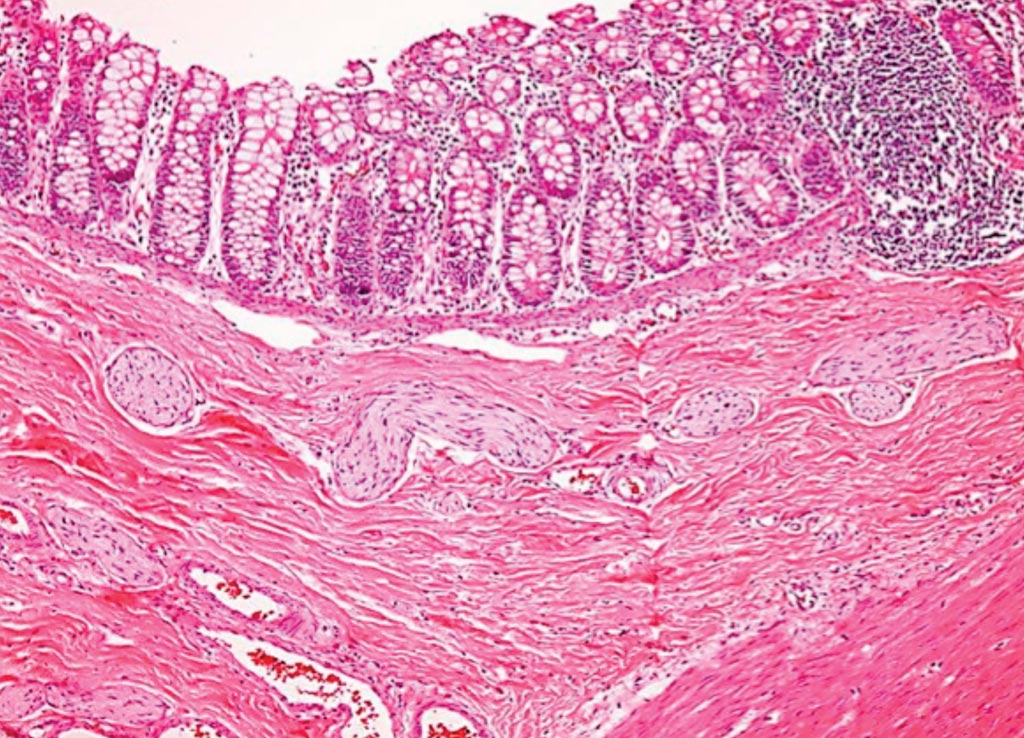Suite of Risk Variants Revealed in Hirschsprung's Disease
By LabMedica International staff writers
Posted on 23 Apr 2019
Hirschsprung’s disease, or congenital aganglionosis, is a developmental disorder of the enteric nervous system and is the most common cause of intestinal obstruction in neonates and infants, often appearing in combination with other symptoms in a manner that may reflect specific syndromes.Posted on 23 Apr 2019
The disease has more than 80% heritability, including significant associations with rare and common sequence variants in genes related to the enteric nervous system, as well as with monogenic and chromosomal syndromes. Genetic factors that contribute to a highly heritable developmental condition of Hirschsprung's disease include a complex suite of risk variants, ranging from common polymorphisms in non-coding elements to rarer coding variants and copy number variants (CNVs).

Image: A histopathology of Hirschsprung’s disease, which is characterized by the absence of parasympathetic ganglion cells in both submucosal as well as myenteric plexuses in the distal gastrointestinal tract (Photo courtesy of Dr. Dharam Ramnani).
Scientists at several institutions collaborated with those at Johns Hopkins University (Baltimore, MD, USA) and genotyped and exome-sequenced samples from 190 patients with Hirschsprung’s disease to quantify the genetic burden in patients with this condition. DNA sequence variants, large CNVs, and karyotype variants in probands were considered to be pathogenic when they were significantly associated with Hirschsprung’s disease or another neurodevelopmental disorder. These were compared with 627 unaffected controls, including 404 participants in the 1000 Genomes Project 223 so-called "pseudo-controls," parental chromosomes that were not transmitted to the affected children.
The team reported that the presence of five or more variants in four noncoding elements defined a widespread risk of Hirschsprung’s disease (48.4% of patients and 17.1% of controls; odds ratio, 4.54. Rare coding variants in 24 genes that play roles in enteric neural-crest cell fate, seven of which were novel, were also common (34.7% of patients and 5.0% of controls) and conferred a much greater risk than noncoding variants (odds ratio, 10.02). Large CNVs, which were present in fewer patients, 11.4%, as compared with 0.2% of controls, conferred the highest risk (odds ratio, 63.07). At least one identifiable genetic risk factor was found in 72.1% of the patients, and at least 48.4% of patients had a structural or regulatory deficiency in the gene encoding receptor tyrosine kinase (RET).
The authors concluded that among the patients in their study, Hirschsprung’s disease arose from common noncoding variants, rare coding variants, and copy-number variants affecting genes involved in enteric neural-crest cell fate that exacerbate the widespread genetic susceptibility associated with RET. The study was published on April 11, 2019, in the New England Journal of Medicine.
Related Links:
Johns Hopkins University














